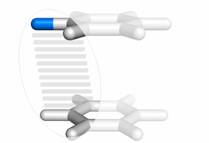58th Annual Report on Research 2013 Under Sponsorship of the ACS Petroleum Research Fund
Reports: DNI650645-DNI6: Intermolecular Non-Covalent Interactions in pi-Conjugated Heterocyclic Oligomers
Steven E. Wheeler, PhD, Texas A&M University
The overarching goal of our ACS-PRF sponsored research program is to study the effects of intermolecular non-covalent interactions on the physical and electronic properties of π-conjugated heterocyclic oligomers. The goal is to understand how these non-covalent interactions can be exploited to tune to solid-state structures and properties of organic electronic materials. At the heart of this work is uncovering how substituents and heteroatoms alter the non-covalent π-stacking and XH/π interactions that are operative in the solid state. During this grant period, we have continued our studies of the nature of substituent effects in π-stacking interactions while also carrying out benchmark studies of the torsional potentials of bifuran, bithiophene, and biselenophene. These benchmark potentials were then used to assess the performance of sundry DFT methods, which allowed us to identify suitable levels of theory for studies of larger conjugated oligomers. Meanwhile, we also worked in collaboration with experimentalists on ways of measuring non-covalent interactions spectroscopically and on ways of synthesizing conjugated organic polymers with smaller PDIs.
Understanding Substituent Effects in Non-Covalent Interactions Involving Aromatic Rings
Non-covalent interactions involving aromatic rings, such as π-stacking, cation/π, and anion/π interactions, are central to the solid state packing or organic electronic materials. Controlling these interactions through the introduction of substituents and heteroatoms will be vital for the development of next-generation materials. Decades of experimental studies have provided key insights into the impact of substituents on these interactions, leading to the development of simple intuitive models. However, gas-phase computational studies have raised some doubts about the physical underpinnings of these widespread models. We recently reviewed our efforts to unravel the origin of substituent effects in π-stacking and ion/π interactions through computational studies of model non-covalent dimers.
First, we dispelled the notion that so-called aromatic interactions depend on the aromaticity of the interacting rings by studying model π-stacked dimers in which the aromaticity of one of the monomers could be “switched off.” Somewhat surprisingly the results show that not only is aromaticity unnecessary for π-stacking interactions, but it actually hinders these interactions to some extent. Consequently, when considering π-stacking interactions, researchers should consider broader classes of planar molecules, not just aromatic systems.
Conventional models maintain that substituent effects in π-stacking interactions result from changes in the aryl π-system. This view suggests that π-stacking interactions are maximized when one ring is substituted with electron-withdrawing groups and the other with electron donors. In contrast to these prevailing models, we have shown that substituent effects in π-stacking interactions can be described in terms of direct, local interactions between the substituents and the nearby vertex of the other arene. Consequently, in polysubstituted π-stacked dimers the substituents operate independently unless they are in each other's local environment. This means that in π-stacked dimers in which one arene is substituted with electron donors and the other with electron acceptors the interactions will be enhanced only to the extent provided by each substituent on its own, unless the substituents on opposing rings are in close proximity. Overall, this local, direct interaction model predicts that substituent effects in π-stacking interactions will be additive and transferable and will also depend on the relative position of substituents on opposing rings.
For cation/π and anion/π interactions, similar π-resonance-based models pervade the literature. Again, computational results indicate that substituent effects in model ion/π complexes can be described primarily in terms of direct interactions between the ion and the substituent, but changes in the aryl π-system do not significantly affect these interactions. We also present a simple electrostatic model that further demonstrates this effect and suggests that the dominant interaction for simple substituents is the interaction of the charged ion with the local dipole associated with the substituents.
Finally, we discussed substituent effects in electrostatic potentials (ESPs), which are widely used in discussions of non-covalent interactions. In the past, widespread misconceptions have confused the relationship between changes in ESPs and local changes in the electron density. We have shown that computed ESP plots of diverse substituted arenes can be reproduced without altering the aryl π-density because substituent-induced changes in the ESP above the center of aryl rings result primarily from through-space effects of substituents rather than through changes in the distribution of the π-electron density.
Performance of DFT Functionals for the Torsional Potentials of Bifuran, Bithiophene, and Biselenophene
The utility of π -conjugated oligomers and polymers continues to grow, and oligofurans, oligothiophenes, and oligoselenophenes have shown great promise in this regard. Vital to the performance of these materials is the maintenance of planarity along the conjugated backbone. Consequently, there has been a great deal of work modeling the torsional behavior of these prototypical components of conjugated organic materials both in the gas- and solid phases. Such simulations have generally relied on classical molecular mechanics force-fields or density functional theory (DFT) potentials.
Unfortunately, no highly accurate benchmark potentials for bifuran, bithiophene, and biselenophene exist against which these lower level theoretical methods can be calibrated. To remedy this absence, we have computed highly accurate torsional potentials based on focal point analyses for these three molecules. These potentials allowed us to assess the performance of multitudinous DFT functional and basis set combinations. Overall, we find that ωB97X and B2PLYP, when paired with the TZVPP or aug-cc-pVTZ basis sets, provide the best performance for all three potentials; M06-2X/6-311++G(d) performs similarly well. These functionals will be used in subsequent studies of larger oligomers. Moreover, our benchmark potentials can be used to calibrate classical molecular mechanics (MM) force fields to provide more realistic simulations of conjugated oligomers in the bulk phase.
Copyright © 2014 American Chemical Society












